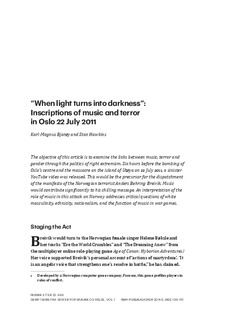| dc.contributor.author | Bjorøy, Karl-Magnus | |
| dc.contributor.author | Hawkins, Stan | |
| dc.date.accessioned | 2015-03-19T14:36:53Z | |
| dc.date.available | 2015-03-19T14:36:53Z | |
| dc.date.issued | 2014 | |
| dc.identifier.citation | I: Musikk etter 22. juli, s. 139-161 | nb_NO |
| dc.identifier.isbn | 978-82-7853-092-4 | |
| dc.identifier.issn | 1893-3580 | |
| dc.identifier.uri | http://hdl.handle.net/11250/279780 | |
| dc.description.abstract | The objective of this article is to examine the links between music, terror and gender through the politics of right extremism. Six hours before the bombing of Oslo’s centre and the massacre on the island of Utøya on 22 July 2011, a sinister YouTube video was released. This would be the precursor for the dispatchment of the manifesto of the Norwegian terrorist Anders Behring Breivik. Music would contribute significantly to his chilling message. An interpretation of the role of music in this attack on Norway addresses critical questions of white masculinity, ethnicity, nationalism, and the function of music in war games. | nb_NO |
| dc.language.iso | eng | nb_NO |
| dc.publisher | Norges musikkhøgskole | nb_NO |
| dc.relation.ispartofseries | Skriftserie fra Senter for musikk og helse;7 | |
| dc.relation.ispartofseries | NMH-publikasjoner;2014:5 | |
| dc.subject | music | nb_NO |
| dc.subject | terrorism | nb_NO |
| dc.subject | gender | nb_NO |
| dc.subject | right-wing extremism | nb_NO |
| dc.title | "When light turns into darkness": Inscriptions of music and terror in Oslo 22 July 2011 | nb_NO |
| dc.type | Chapter | nb_NO |
| dc.type | Peer reviewed | nb_NO |
| dc.subject.nsi | VDP::Humanities: 000::Musicology: 110::Music theory: 112 | nb_NO |
| dc.source.pagenumber | S. 139-161 | nb_NO |
